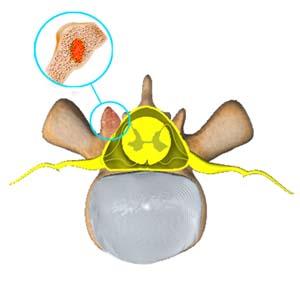
What is a Spinal Tumor?
A spinal tumor is an abnormal mass of tissue surrounding or found within your spinal cord and/or spinal column.
Types of Spinal Tumors
Spinal tumors can be described in various ways based on their characteristics and location:
- Primary tumors: Originate in your spinal column or spinal cord.
- Secondary tumors: Spread from another part of your body to the spine (metastasis).
- Benign (non-cancerous).
- Malignant (cancerous).
- Cervical.
- Thoracic.
- Lumbar.
- Sacral.
- Intradural extramedullary.
- Intramedullary.
- Extradural.
Spinal tumors that originate within the spinal cord or spinal column are named according to the tissues in which they develop:
- Meningiomas.
- Schwannomas.
- Neurofibromas.
- Ependymomas.
- Astrocytomas.
- Lipomas.
Indications for Spinal Tumor Surgery
Treatment for a spine tumor may be nonsurgical or surgical depending on the characteristics of the tumor and your overall health.
Primary spinal tumors may be resected whole to cure the condition.
In cases of metastatic tumors, your doctor may recommend surgery if:
- You have pain that cannot be managed with conservative treatments.
- The tumor is compressing on the spinal cord or nerves.
- Your spine requires stabilization as it may fracture due to a growing tumor.
Surgery for metastatic tumors thus focuses on improving your quality of life.
Goals of Spinal Tumor Surgery
The goals of spinal tumor surgery include:
- Remove the tumor to the greatest extent possible.
- Minimize damage to the spine and surrounding structures.
- Improve the stability of your spine.
Surgery to Treat a Spine Tumor
If surgical resection is possible, your doctor may perform a preoperative embolization procedure. During this procedure, your doctor will:
- Insert a catheter (flexible tube) through an artery in the groin.
- Guide the catheter up via the blood vessels to reach the tumor.
- Deliver a glue-like liquid embolic agent that blocks the vessels feeding the tumor.
This procedure helps control bleeding during surgical removal of the tumor.
The spinal tumor may be approached from the back or front of the spine depending on its location. For extensive tumors (usually of the thorax and lumbar spine), surgery may be performed in stages, first approaching the tumor from the back and then the front.
All or part of the tumor may be removed to decompress the spine. This may be done at multiple levels and may involve the removal of vertebral bodies. Unstable areas of the spine are stabilized using fixation devices.
Recovery After Spinal Tumor Surgery
After surgery, your hospital stay may range from 2 to 14 days depending on your condition. You may be asked to participate in a physical rehabilitation program either in a hospital, outpatient facility or at home.
Prognosis
Your recovery after spine surgery greatly depends on:
- Your age and overall health.
- The type and extent of the tumor.
- The complexity of your surgery.
The recovery time after the surgery may last three months or extend up to a year.



